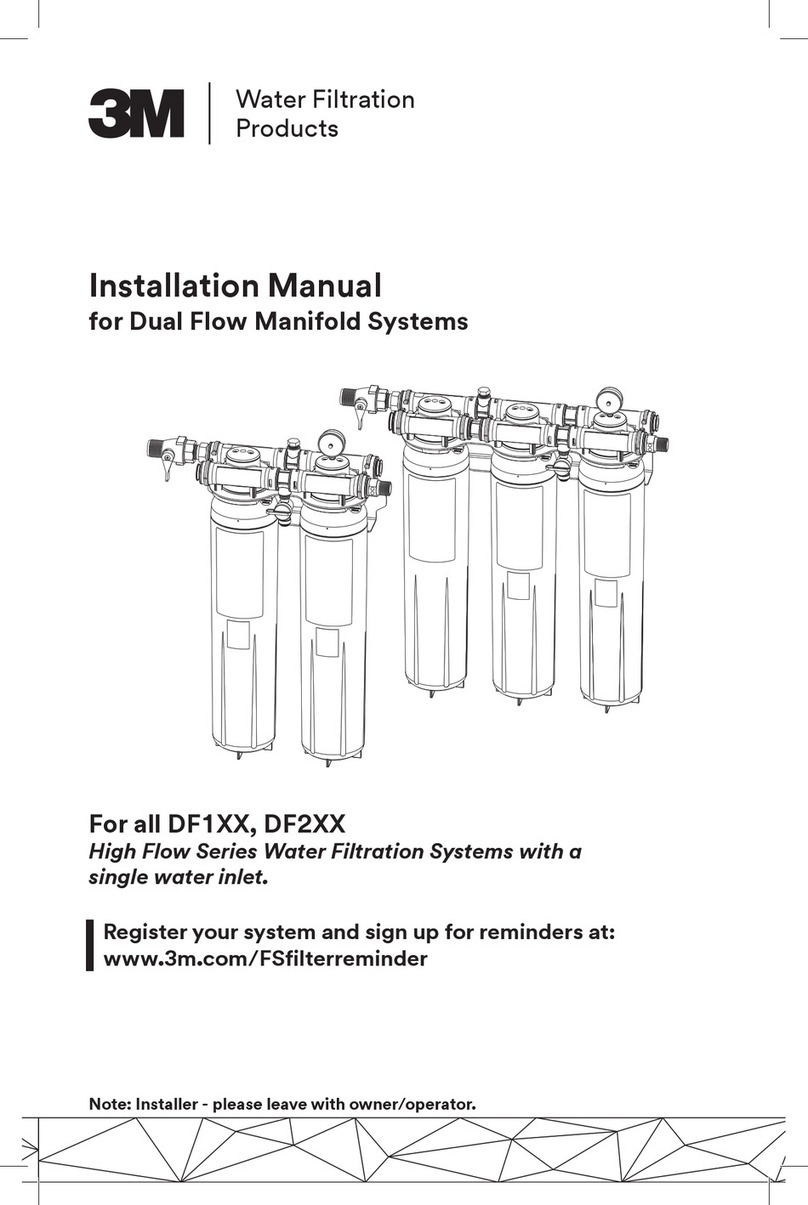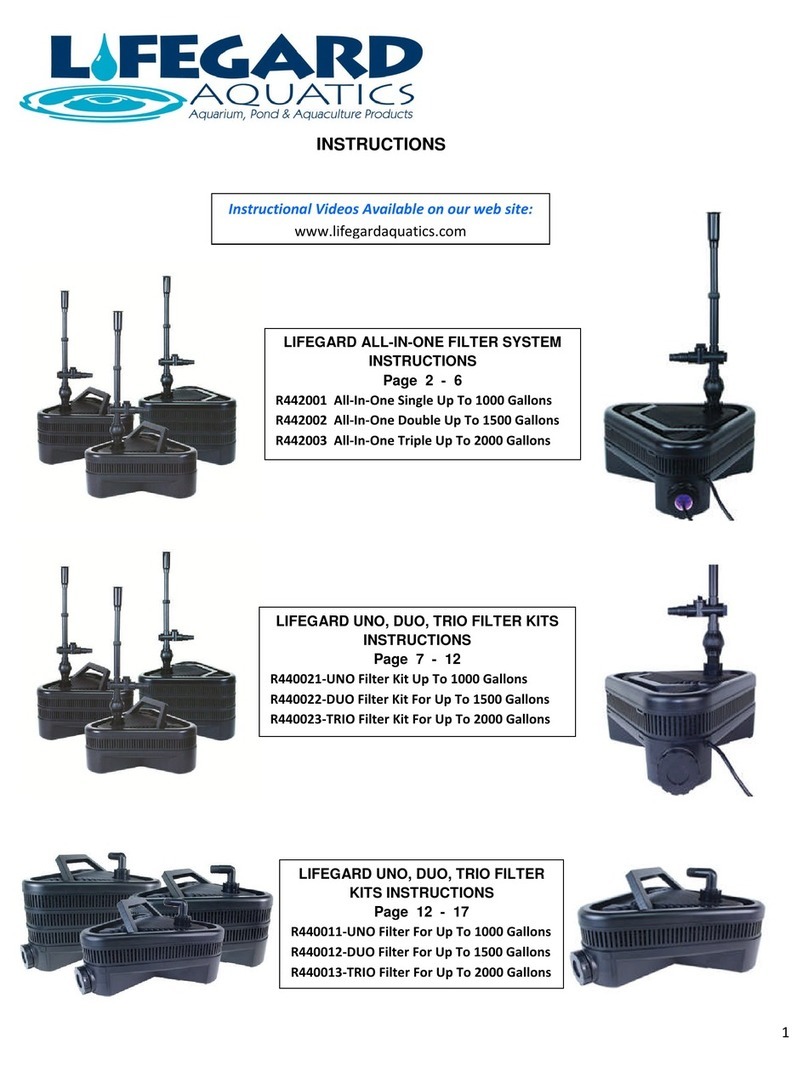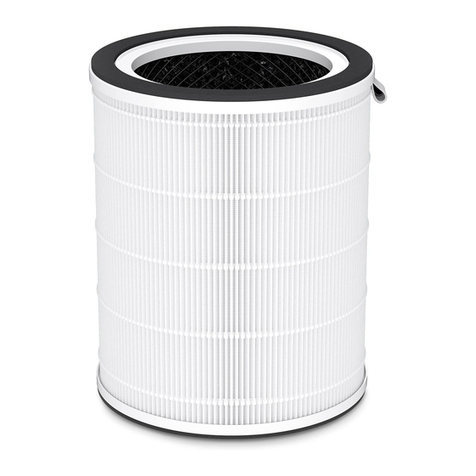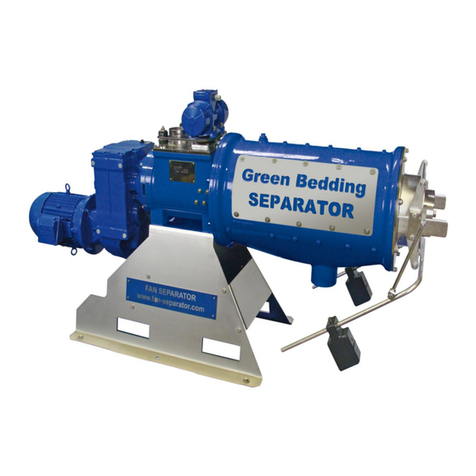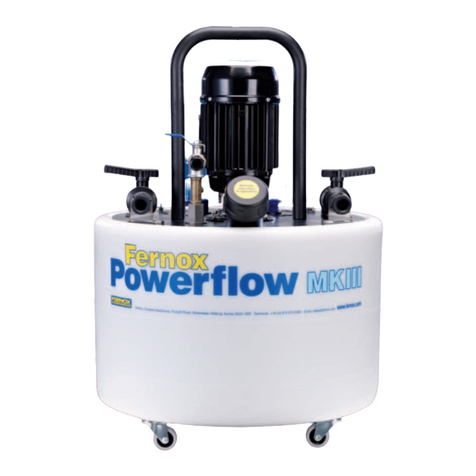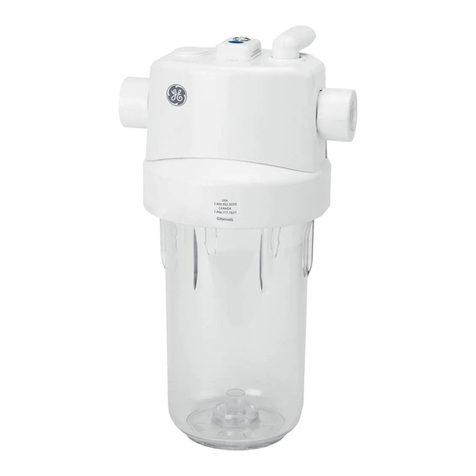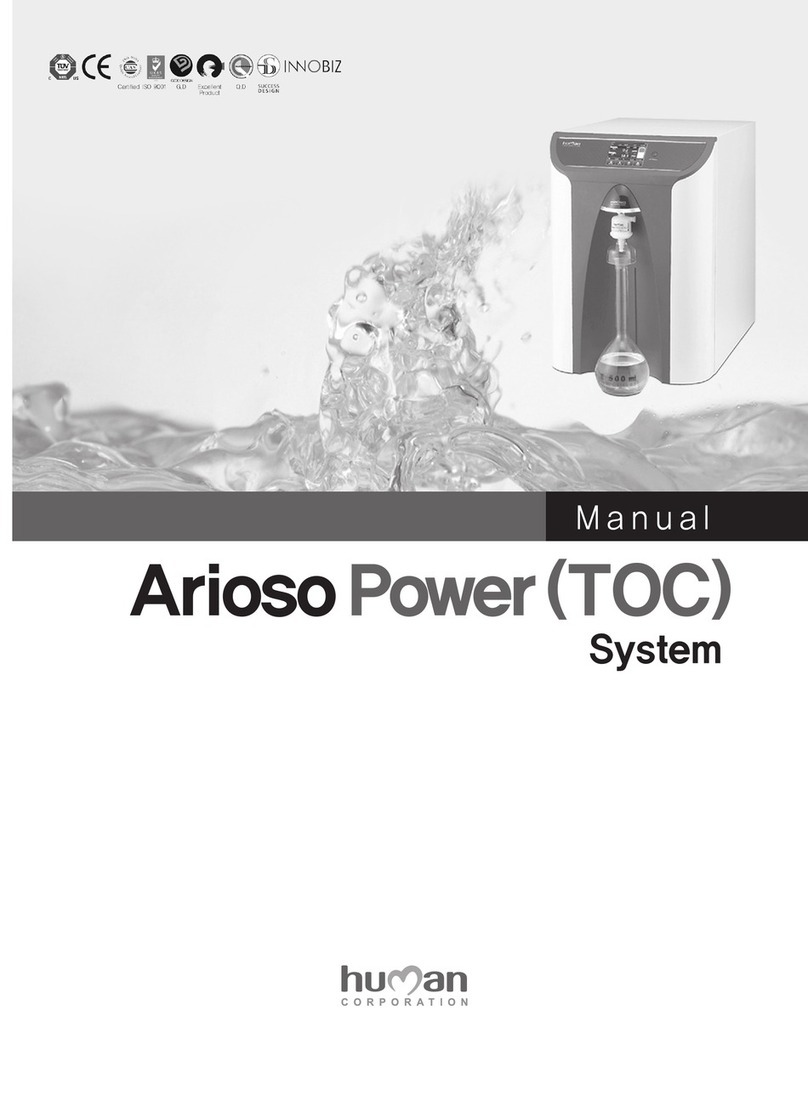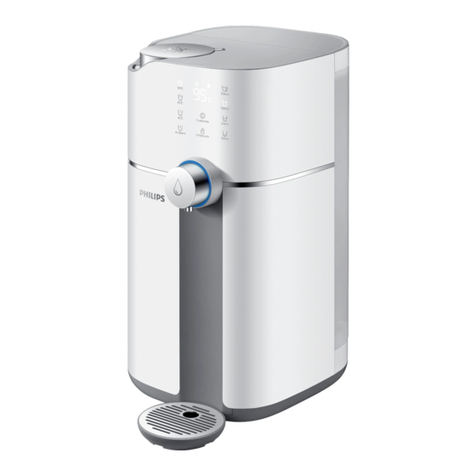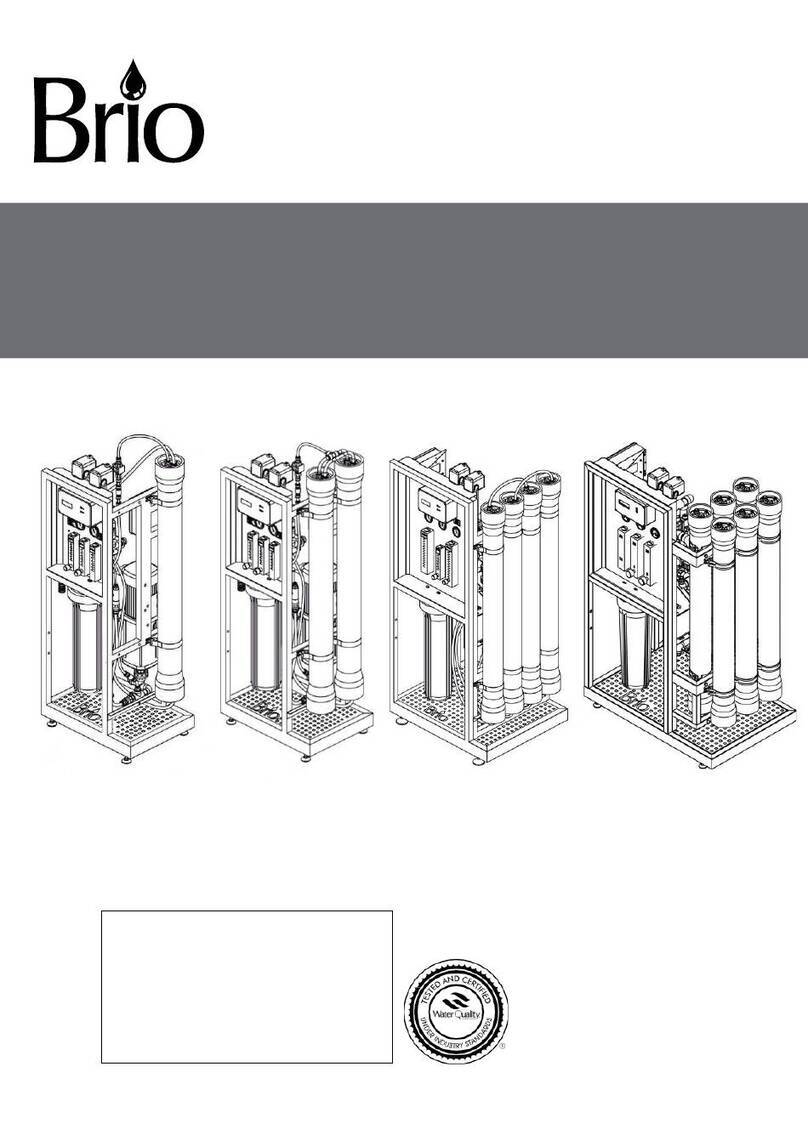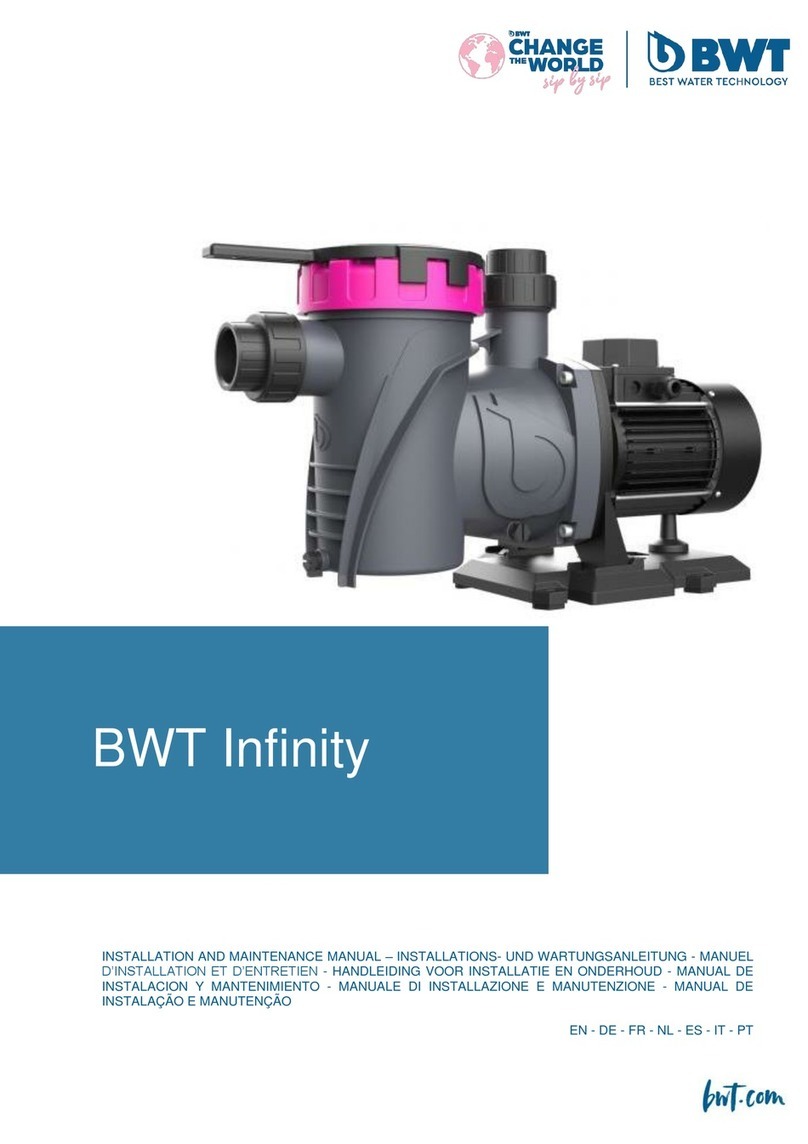SciCan HYDROS User manual

HYDROS
WATER TREATMENT SYSTEM
HYDROS Operator’s Manual PN: 1008201-001 Copyright 2016 SciCan Ltd. All rights reserved.
Handbuch
Manual
Mode d’emploi
Handboek
Manuale
Manual
Podręcznik
Инструкция
Deutsch Seite 2–10
1 Begriffsübersicht
2 Allgemeine Informationen
3 Betriebs- und Sicherheitshinweise
4 Installation
5 Inbetriebnahme eines Neufilters
6 Austausch der Filterkartusche
7 Filterkapazität
8 Instandhaltung
9 Fehlerbehebung
10 Technische Daten
11 Bestellnummern
English Page 11–19
1 Definition of Terms
2 General Information
3 Operating and Safety Information
4 Installation
5 Commissioning a New Filter
6 Exchanging the Filter Cartridge
7 Filter Capacity
8 Repair
9 Troubleshooting
10 Technical Data
11 Order Numbers
Français Page 20–28
1 Eléments
2 Généralités
3 Consignes d’utilisation et de sécurité
4 Installation
5 Mise en service d’un nouveau filtre
6 Remplacement de la cartouche filtrante
7 Capacité de filtration
8 Entretien
9 Dépannage
10 Caractéristiques techniques
11 Références
Nederlands Pagina 29–37
1 Overzicht van de begrippen
2 Algemene Informatie
3 Gebruiks- en veiligheidsvoorschriften
4 Installatie
5 Inbedrijfstelling van een nieuw filterpatroon
6 Vervangen van de filterpatroon
7 Filtercapaciteit
8 Onderhoud
9 Verhelpen van fouten
10 Technische gegevens
11 Bestelnummers
Italiano Pagina 38–47
1 Panoramica delle definizioni
2 Informazioni generali
3 Istruzioni di funzionamento e sicurezza
4 Installazione
5 Messa in funzione di un nuovo filtro
6 Sostituzione della cartuccia filtrante
7 Capacità filtrante
8 Manutenzione
9 Eliminazione guasti
10 Dati tecnici
11 Numeri d‘ordine
Español Página 48–57
1 Términos
2 Información general
3 Indicaciones de funcionamiento y seguridad
4 Instalación
5 Puesta en marcha de un filtro nuevo
6 Cambio del cartucho filtrante
7 Capacidad del filtro
8 Mantenimiento
9 Solución de fallos
10 Datos técnicos
11 Números de pedido
Polski Strona 58–67
1 Przegląd pojęć
2 Informacje ogólne
3 Wskazówki dotyczące użytkowania
i bezpieczeństwa
4 Instalacja
5 Rozruch nowego filtra
6 Wymiana wkładów filtracyjnych
7 Wydajność filtra
8 Konserwacja
9 Usuwanie usterek
10 Dane techniczne
11 Numery zamówień
Русский Страница 68–76
1 Термины
2 Общие сведения
3 Руководство по использованию и безопасности
4 Установка
5 Ввод в эксплуатацию нового фильтра
6 Замена картриджа
7 Ресурс фильтра
8 Уход за фильтром
9 Устранение неполадок
10 Технические параметры
11 Артикулы для заказа
Manufactured for:
SciCan Ltd.
1440 Don Mills Rd.
Toronto, ON M3B 3P9
Canada
(416) 445-1600
(800) 667-7733
Return exhausted filters to:
SciCan GmbH
Wangener Strasse 78
88299 Leutkirch im Allgäu
GERMANY
Tel.: +49 (0)7561 98343 - 0
Fax: +49 (0)7561 98343 - 699
www.scican.de.com

9
11
3
4
6
7
5
8
2
1
14
12
10
15
16
1 Begriffsübersicht
1Druckbehälter
2Filterkartusche
3Druckbehälterdeckel
4Anschlusskopf
5Eingangsschlauch
6Eingangsventil am Eingangsschlauch
7Ausgangsschlauch zum Endgerät
8Verschlusssicherung
9Trittlaschen
10 Auswerfersockel
11 Mantelgriffe
12 Transportschutzkappe
13 Deckelgriff
14 Reduzierstück 1"– 3/4"
15 Spülventil mit Spülschlauch
2 Allgemeine Informationen
2.1 Funktion und Anwendungsbereich
Das HYDROS Aufbereitungssystem optimiert Leitungswasser mit Hilfe von vollstän-
diger Entmineralisierung.
Durch das HYDROS Aufbereitungssystem werden dem Wasser im Durchflussverfahren
über einen Ionenaustauscher selektiv Calcium- und Magnesium-Ionen entzogen.
Karbonathärtebedingte Rückstände beim Trocknen der zahnärztlichen Instrumente
sowie Kalkablagerungen an wichtigen Maschinenteilen werden verhindert.
Darüber hinaus beseitigt das HYDROS Aufbereitungssystem Salze im Wasser durch
Entmineralisierung, wodurch verhindert wird, dass sich Salze auf Instrumenten ablagern.
2.2 Gewährleistungsbestimmungen
Die HYDROS Aufbereitungssystem der gesetzlichen Gewährleistung von zwei Jahren.
Ein Gewährleistungsanspruch kann nur geltend gemacht werden, wenn alle Hinweise
dieser Anleitung befolgt und beachtet werden.
2.3 Lagerung / Transport
Umgebungsbedingungen bei Lagerung und Transport in den technischen Daten
(Kapitel 10) beachten.
Das Handbuch ist als Teil des Produkts zu verstehen und während der gesamten
Lebensdauer des Filtersystems aufzubewahren und an nachfolgende Besitzer
weiterzugeben.
2

2.4 Recycling/Entsorgung
Durch die ordnungsgemäße Entsorgung dieses Produkts und seiner Verpackungsbestand-
teile tragen Sie dazu bei, potenzielle negative Auswirkungen auf Mensch und Umwelt zu
vermeiden, die durch die unsachgemäße Entsorgung auftreten könnten. Bitte führen Sie
die zu entsorgenden Einheiten gemäß den örtlichen Bestimmungen einem geordneten
Recycling zu. Erschöpfte Filterkartuschen können im Originalkarton an die entsprechende
auf der Umschlagrückseite dieses Handbuches aufgeführte SciCan GmbH-Adresse
zurückgeschickt werden.
3 Betriebs- und Sicherheitshinweise
3.1 Qualifiziertes Personal
Installation und Instandhaltung des Filtersystems darf nur von geschultem und autorisiertem
Personal vorgenommen werden.
3.2 Bestimmungsgemäßer Gebrauch
Der einwandfreie und sichere Betrieb des Produkts setzt die in diesem Handbuch
beschriebene Vorgehensweise für Installation, Gebrauch und Instandhaltung voraus.
Verwenden Sie nur Filterpatronen, die für dieses Gerät geeignet sind.
Hinweis: Das HYDROS Aufbereitungssystem und systemspezifische Filterpatronen
können ausschließlich mit den Geräten C61wd G4 und M2 G4 verwendet werden.
3.3 Haftungsausschluss
Die Installation muss genau nach den Angaben in diesem Handbuch ausgeführt werden.
SciCan haftet nicht für etwaige Schäden einschließlich Folgeschäden, die durch falsche
Installation oder falschen Gebrauch des Produkts entstehen können.
3.4 Spezifische Sicherheitshinweise
• Als Wasser für das HYDROS Wasserfiltersystem darf ausschließlich Trinkwasser
innerhalb des in Kapitel 10 angegebenen Wassereingangstemperaturbereichs ver-
wendet werden. Keinesfalls darf mikrobiologisch belastetes Wasser oder Wasser
unbekannter mikrobiologischer Qualität ohne angemessene Sterilisierung eingesetzt
werden.
• SciCan empfiehlt, das Filtersystem nicht über einen längeren Zeitraum außer Betrieb
zu nehmen. Nach Stagnationszeiten von über 4 Wochen sollte eine Behälterspülung
oder ein Vorspülgang durchgeführt werden. Bitte beachten Sie hierzu auch die
maximale Einsatzdauer der Filterkartusche von 12 Monaten (Kapitel 6).
• Das Filtersystem ist nicht beständig gegen stark konzentrierte Reinigungsmittel
(z. B. Bleichmittel, chlorierte Lösungsmittel, starke Oxidationsmittel) und darf nicht
damit in Kontakt kommen.
• Während des Betriebs darf das Filtersystem nicht geöffnet oder demontiert werden.
Die Filterkartusche darf nicht geöffnet werden.
• Druckbehälter und Druckbehälterdeckel des Filtersystems sind bei sachgemäßer
Installation und Nutzung sowie bei Einhaltung der in den technischen Daten genann-
ten Betriebsbedingungen auf eine Lebensdauer von bis zu 10 Jahren ausgelegt (ab
Installationsdatum). Spätestens nach Ablauf von 10 Jahren muss in jedem Fall ein
Austausch erfolgen. Die Schläuche müssen turnusgemäß spätestens nach 5 Jahren
ausgewechselt werden.
3

• Produktionsdatum:
Produktionscodeaufkleber Filterkartusche und Umkarton, Beispiel: B715002010
7Produktionsjahr, hier: 2007
15 Produktionswoche, hier: Kalenderwoche 15
002 Chargen-Nr. Filtermedium, hier die mengenmäßig abgefüllte zweite Charge
010 laufende Nummer der Filterkartusche, hier die zehnte Kartusche aus der zweiten Charge
Produktionscodeaufkleber Anschlusskopf, Beispiel: 7102 XX
7Produktionsjahr, hier: 2007
10 Produktionswoche, hier: Kalenderwoche 10
2 Produktionstag von Montag (1) bis Freitag (5), hier: Dienstag
XX Interne Kennziffer
Produktionsdatum Druckbehälter und Druckbehälterdeckel, Beispiel: 0307
03 Produktionsmonat, hier: März
07 Produktionsjahr, hier: 2007
3.5 Sicherheitstechnische Montagehinweise
• Das mit dem Filter betriebene Endgerät muss vor Installation kalkfrei sein.
!Achtung: Vor dem Filtersystem darf keine Enthärtungsanlage betrieben werden.
• Filtersystem vor Sonneneinstrahlung und mechanischen Beschädigungen schützen.
Nicht in der Nähe von Hitzequellen und offenem Feuer montieren.
• Vor dem Eingangsschlauch des Filtersystems muss ein Absperrventil installiert sein.
• Ist der Wasserdruck größer als 6 bar, muss ein Druckminderer vor das Filtersystem
eingebaut werden.
• Am Wassereingang des Filterkopfs ist ein vom DVGW baumustergeprüfter
Rückflussverhinderer werksseitig eingebaut.
• Zwischen Wasserfilter und Endgerät dürfen keine Kupferrohre und keine verzinkten
oder vernickelten Rohre/Verbindungsstücke eingebaut sein. Bei der Werkstoffauswahl
von wasserberührenden Teilen nach dem HYDROS Filtersystem muss beachtet
werden, dass das entkarbonisierte bzw. vollentsalzte Wasser verfahrensbedingt freie
Kohlensäure enthält. Die Verwendung vom HYDROS Schlauchset wird empfohlen.
• Die Installation aller Teile ist entsprechend der länderspezifischen Richtlinien zur
Installation von Wassereinrichtungen durchzuführen.
4

4 Installation
!Achtung: Vor Installation die technischen Daten (Kapitel 10) und die Betriebs- und
Sicherheitshinweise (Kapitel 3) beachten. Nach Lagerung unter 0°C ist das Produkt
bei geöffneter Originalverpackung mindestens 24 Stunden vor Inbetriebnahme bei Um-
gebungstemperatur des Installationsorts zu lagern.
4.1 Lieferumfang
Nehmen Sie vor der Installation den gesamten Lieferumfang aus der Verpackung und
prüfen Sie diesen auf Vollständigkeit:
1x Druckbehälter 1
1x Druckbehälterdeckel 3
1x Filterkartusche 2
1x Handbuch
1x Karbonathärtetest bzw. Gesamthärtetest
1x Aufkleber für Service-Pass
1x Reduzierstück 1"– 3/4"
1x Spülventil mit Spülschlauch
Sollten Teile des Lieferumfangs fehlen, wenden Sie sich bitte an die für Sie zuständige
SciCan Geschäftsstelle (siehe Umschlagrückseite).
4.2 Montage des Druckbehälters und Druckbehälterdeckels
• Mit beiden Füßen auf die Trittlaschen 9stellen.
• Druckbehälter 1anheben und im Uhrzeigersinn drehen, bis
Mantelgriffe 11 über den Trittlaschen 9stehen.
• Transportschutzkappe 12 von Filterkartusche entfernen.
• O-Ring-Dichtung der Filterkartusche 2auf korrekten Sitz in Nut,
Verschmutzung und Beschädigung überprüfen.
Hinweis: Der Kartuschensitz ist werkseitig mit lebensmittelechtem
Schmiermittel gefettet.
• Mit beiden Füßen auf die Trittlaschen 9stellen und Druckbehälter-
deckel 3auf Druckbehälter 1aufsetzen. Die Positionierung der
Pfeilmarkierung am Deckelgriff 13 muss dabei mit Nut „INSERT“
übereinstimmen.
• Druckbehälterdeckel 3nach unten drücken und im Uhrzeigersinn bis zum Einrasten
der Verschlusssicherung 8drehen.
4.3 Montage der Eingangs- und Ausgangsschläuche
Hinweis: Die Eingangs- und Ausgangsschläuche sind nicht im Standardlieferumfang
enthalten. Die Verwendung von HYDROS Schlauchsets wird empfohlen.
• Eingangsschlauch 5am Eingang des Anschlusskopfs 4und Ausgangsschlauch 7
am Ausgang des Anschlusskopfs 4montieren.
Hinweis: Eingang „IN“ und Ausgang „OUT“ des Anschlusskopfs 4sind mit O-Rin-
gen als Dichtungen ausgestattet; deshalb dürfen hier keine zusätzlichen Flachdichtun-
gen verwendet werden. Auf korrekten Sitz der O-Ringe achten.
5

!Achtung: Das maximale Anzugsdrehmoment an den 1"- und 3/4"-Anschlüssen darf
15 Nm nicht überschreiten! Es dürfen nur Schlauchanschlüsse mit Flachdichtungen ein-
gesetzt werden. Schläuche mit konischen Verschraubungen beschädigen die Anschlüsse
des Filterkopfs und führen zum Erlöschen des Gewährleistungsanspruchs!
Vor Montage Fließrichtung an der Oberseite des Filterkopfs beachten, IN = Wasser-
eingang, OUT = Wasserausgang. Vor Installation Einbauabmessungen und Betriebslage
(Kapitel 10) beachten. Werden keine Originalschläuche verwendet, muss das mitgelie-
ferte Reduzierstück 1"–3/4" 14 verwendet werden, um eine korrekte Abdichtung des
Rückflussverhinderers zu gewährleisten.
5 Inbetriebnahme eines Neufilters
5.1 Bestimmung der Filterkapazität
• Bestimmung der lokalen Karbonathärte bzw. Gesamthärte mittels dem zu Ihrem
HYDRIM-Gerät mitgelieferten Gesamthärtetest.
• Bestimmung der Filterkapazität mittels der Kapazitätstabellen (Kapitel 7) unter
Berücksichtigung der ermittelten Karbonat- bzw. Gesamthärte und des eingestellten
Verschnitts (Kapitel 5.1).
5.2 Einspülen und Entlüften der Filterkartusche
Hinweis: Zum Einspülen/Entlüften wird ein Eimer mit mindestens 10 Liter Fassungs-
vermögen benötigt.
• Eimer unter Spülschlauch stellen und Spülventil 15 öffnen.
• Eingangsventil 6am Eingangsschlauch 5öffnen, dabei
Spülschlauch im Eimer festhalten. Mit mindestens 10 Liter spülen.
• Spülventil 15 schließen und Eimer entleeren.
• System auf eventuelle Leckagen prüfen.
• Installationsdatum des Filtersystems auf dem Druckbehälter 1und
nächstes Austauschdatum auf dem beiliegenden Aufkleber
vermerken und diesen auf dem Service-Pass auf dem Druckbehälter
1anbringen.
10 L
6

6 Austausch der Filterkartusche
Der Austausch der Filterkartusche muss nach 6 bis 12 Monaten erfolgen, spätestens
12 Monate nach Inbetriebnahme, unabhängig vom Erschöpfungsgrad der Filterkartusche.
Ist die Kapazität der Filterkartusche bereits vorher erschöpft (Kapitel 7), muss der Aus-
tausch früher erfolgen.
!Achtung: Beim Austausch alle demontierten Teile sorgfältig untersuchen! Defekte
Teile müssen ausgetauscht, verunreinigte Teile gereinigt werden! Vor Austausch die
Betriebs- und Sicherheitshinweise (Kapitel 3) beachten. Nach Lagerung unter 0°C ist das
Produkt bei geöffneter Originalverpackung mindestens 24 Stunden vor Inbetriebnahme
unter der Umgebungstemperatur des Installationsortes zu lagern.
6.1 Entnehmen der Filterkartusche
• Spannungsversorgung des HYDRIM-Geräts abschalten (Netzstecker ziehen).
• Eingangsventil 6am Eingangsschlauch 5schließen.
• Spülschlauch in einen Eimer stecken und durch Öffnen des Spülventils 15 Filter-
system drucklos machen. Die austretende Wassermenge in einem Eimer auffangen.
Hinweis: Wenn die austretende Wassermenge 1 Liter überschreitet, ist das Eingangs-
ventil 6nicht komplett geschlossen oder verkalkt.
• Mit beiden Füßen auf die Trittlaschen 9stellen und dabei den Druck-
behälterdeckel 3durch Drücken der Verschlusssicherung 8und
durch gleichzeitiges Drehen gegen den Uhrzeigersinn bis zum
Anschlag öffnen.
• Druckbehälterdeckel 3vertikal auf den Deckelgriff 13 abstellen.
• Mit beiden Füßen auf die Trittlaschen 9stellen und dabei Druck-
behälter 1an den Mantelgriffen 11 gegen den Uhrzeigersinn bis zum
Anschlag drehen.
• Füße von den Trittlaschen 9nehmen und Druckbehälter 1mit beiden Händen an
den Mantelgriffen 11 nach unten drücken.
• Erschöpfte Filterkartusche 2aus dem Druckbehälter 1entnehmen.
• Erschöpfte Filterkartusche 2zum Entleeren mit Anschluss nach unten in Spüle
stellen (> 5 Min.).
• Erschöpfte Filterkartusche 2mit der Transportschutzkappe 12 der neuen Filterkar-
tusche verschließen und gemäß den örtlichen Bestimmungen entsorgen oder diese
im Originalkarton an die entsprechende auf der Umschlagrückseite dieses Handbu-
ches aufgeführte SciCan GmbH-Adresse zurückschicken.
6.2 Einsetzen der Filterkartusche
• O-Ring-Dichtung der neuen Filterkartusche 2auf korrekten Sitz in
Nut, Verschmutzung und Beschädigungen überprüfen.
Hinweis: Der Kartuschensitz ist werkseitig mit lebensmittelechtem
Schmiermittel gefettet.
• Anschlusssitz für den O-Ring der Filterkartusche 2im Druckbehäl-
terdeckel 3auf Schmutz und Beschädigungen überprüfen.
• Neue Filterkartusche 2in den Druckbehälter 1einsetzen.
• Mit beiden Füßen auf die Trittlaschen 9stellen, Druckbehälter 1
anheben und dabei im Uhrzeigersinn drehen, bis Mantelgriffe 11 über
den Trittlaschen 9stehen.
7

• Mit beiden Füßen auf die Trittlaschen 9stellen und Druckbehälter-
deckel 3auf Druckbehälter 1aufsetzen. Die Positionierung der
Pfeilmarkierung am Deckelgriff 13 muss dabei mit Nut „INSERT“
übereinstimmen.
• Druckbehälterdeckel 3nach unten drücken und im Uhrzeigersinn bis
zum Einrasten der Verschlusssicherung 8drehen.
• Spannungsversorgung des HYDRIM-Geräts einschalten (Netzstecker).
• Zum Einspülen und Entlüften der neuen Filterkartusche 2Schritte
unter 5.3 durchführen.
7 Filterkapazität
Kapazitätstabellen
HYDROS HYDROS
Gesamthärte
in °GH
Volumen
in Liter
Gesamthärte
in °GH
Volumen
in Liter
Volumen
in Liter
4 12.500 4 12.500 13.611
5 10.000 5 10.000 10.889
6 8.333 6 8.333 9.074
7 7.143 7 7.143 7.778
8 6.250 8 6.250 6.806
9 5.556 9 5.556 6.049
10 5.000 10 5.000 5.444
11 4.545 11 4.545 4.949
12 4.167 12 4.167 4.537
13 3.846 13 3.846 4.188
14 3.571 14 3.571 3.889
15 3.333 15 3.333 3.630
16 3.125 16 3.125 3.403
17 2.941 17 2.941 3.203
18 2.778 18 2.778 3.025
19 2.632 19 2.632 2.865
20 2.500 20 2.500 2.722
21 2.381 21 2.381 2.593
23 2.174 23 2.174 2.367
25 2.000 25 2.000 2.178
28 1.786 28 1.786 1.944
31 1.613 31 1.613 1.756
35 1.429 35 1.429 1.556
Hinweis: Die angegebenen Kapazitäten sind Richtwerte, die je nach Produktvolumenstrom,
lokaler Wasserqualität und Maschinentyp um ± 20% variieren können.
8

8 Instandhaltung
Prüfen Sie das Filtersystem regelmäßig auf Leckagen. Prüfen Sie die Schläuche regel-
mäßig auf Knickstellen. Geknickte Schläuche müssen ersetzt werden.
Das komplette Filtersystem muss turnusgemäß nach spätestens 10 Jahren ausgewech-
selt werden.
Die Schläuche müssen turnusgemäß spätestens nach 5 Jahren ausgewechselt werden.
!Achtung: Vor Auswechslung die technischen Daten (Kapitel 10) und die Betriebs- und
Sicherheitshinweise (Kapitel 3) beachten.
Reinigen Sie das Filtersystem außen regelmäßig mit einem weichen, feuchten Tuch.
!Achtung: Verwenden Sie dabei keine materialunverträglichen Stoffe (Kapitel 3.4) oder
scharfe, scheuernde Reinigungsmittel.
9 Fehlerbehebung
9.1 Kein Wasserfluss
Ursache: Wasserzufuhr geschlossen.
Fehlerbehebung: Wasserzufuhr am vorgeschalteten Absperrventil oder Eingangsventil 6
am Eingangsschlauch 5öffnen.
!Achtung: Die nachfolgenden Fehler dürfen nur von geschultem und autorisiertem
Personal behoben werden.
9.2 Kein oder geringer Wasserfluss trotz geöffneter Wasserzufuhr
Ursache: Leitungsdruck zu gering.
Fehlerbehebung: Leitungsdruck überprüfen.
Falls der Fehler trotz ausreichendem Leitungsdruck weiterhin auftritt,
Filtersystem und Filterkartusche überprüfen und ggf. auswechseln.
!Achtung: Vor Auswechslung die technischen Daten (Kapitel 10) und
die Betriebs- und Sicherheitshinweise (Kapitel 3) beachten.
9.3 Leckage an Verschraubungen
Ursache: Verschraubungen nicht ordnungsgemäß montiert.
Fehlerbehebung: Leitungsdruck überprüfen. Sämtliche Verschraubungen überprüfen und
gemäß Kapitel 4 montieren.
Falls der Fehler weiterhin auftritt, Filtersystem auswechseln.
!Achtung: Vor Auswechslung die technischen Daten (Kapitel 10) und
die Betriebs- und Sicherheitshinweise (Kapitel 3) beachten.
9.4 Leckage nach Filtertausch
Ursache: O-Ring an Filterkartusche sitzt nicht korrekt.
Fehlerbehebung: Korrekten Sitz des O-Rings überprüfen (Kapitel 6.2).
!Achtung: Vor Demontage die technischen Daten (Kapitel 10) und
die Betriebs- und Sicherheitshinweise (Kapitel 3) beachten.
9

10 Technische Daten
HYDROS
Betriebsdruck 2 bar – max. 6 bar
Betriebs-/Wassertemperatur 4°C – 60 °C
Umgebungstempe-
ratur bei
Betrieb 10°C – 60°C
Lagerung/Transport –20 °C – 60 °C
Durchfluss bei 1 bar Druckverlust 850 l/h
Nenndurchfluss gemäß Norm 300 l/h
Druckverlust bei Nenndurchfluss 0,45 bar
Gewicht (trocken/nass) 18 kg/24 kg
Abmessungen Komplettsystem
(Breite/Tiefe/Höhe)
288 mm/255 mm/550 mm
Die Biegeradien des Eingangs- und Ausgangsschlauchs 2 m, DN13, 3/4"–3/4" betragen 130 mm und sind je
nach räumlicher Einbauorientierung und Betriebslage zusätzlich zu den Abmessungen des Komplettsystems zu
berücksichtigen.
Betriebslage Das Filtersystem kann wahlweise stehend oder liegend betrieben
werden.
Eingangsanschluss G 1"
Ausgangsanschluss G 3/4"
11 Bestellnummern
Filtersystem HYDROS 1200 Clean Extra
Artikel Artikel-Nummer
HYDROS (Komplettsystem mit Filterkartusche) 01-114436
HYDROS Wechselkartusche 01-114450
HYDROS Schlauchset 01-114546
HYDROS Volumenzähler 01-114547
10

1 Definition of Terms
1Pressure Vessel
2Filter Cartridge
3Pressure Vessel Lid
4Connector Head
5Inlet Hose
6Inlet Valve on the Inlet Hose
7Outlet Hose to the End Device
8Locking
9Kick Loop
10 Ejector Base
11 Mantle Handle
12 Transport Protective Cap
13 Lid Handle
14 Reducer 1"– 3/4"
15 Flush valve with flush hose
2 General Information
2.1 Function and Application
The HYDROS Treatment System optimises tap water by means of full
demineralisation.
In the HYDROS Treatment System calcium and magnesium ions are selectively
removed from the drinking water via an ion exchanger using the flow method. This
prevents residues on the dental instruments during drying due to carbonate hardness
and scale deposits on important machine parts.
Furthermore, the HYDROS Treatment System removes salts in the water by means of
full demineralisation of the tap water, preventing them from being deposited on instru-
ments.
2.2 Guarantee Provisions
The HYDROS Treatment System is subject to the statutory guarantee of 2 years. A
guarantee claim may be asserted only if all instructions in this Handbook are followed
and observed.
2.3 Storage/Transport
Adhere to the ambient conditions in the Technical Data (Chapter10) for storage and
transport.
The handbook should be seen as part of the product and kept for the whole service
life of the filter system and passed on to subsequent owners.
11

2.4 Recycling/Disposal
By disposing of this product and its packaging in the correct manner you are helping to
prevent potential negative impacts on people and the environment that could be caused
by incorrect disposal. Comply with local regulations and bring the units to be disposed of
to a proper recycling facility.
3 Operating and Safety Information
3.1 Qualified Personnel
Installation and maintenance of the filter system may be carried out only by trained or
authorised personnel.
3.2 Correct Use
The product can only be operated properly and safely if it is installed, used and serviced
in the manner described in this Manual. Use only filter cartridges suitable for this appliance.
Note: the HYDROS Treatment System and system-specific filter cartridges may only
be used with the C61wd G4 and M2 G4 units.
3.3 Liability Exclusion
Installation must be carried out in accordance with the instructions in this Manual. SciCan
shall not be held liable for any damage, including subsequent damage, arising from the
incorrect installation or use of the product.
3.4 Specific Safety Information
• Only drinking water within the intake water temperature range listed in Chapter 10
may be used as intake water for the HYDROS water filter system.
No microbiologically impaired water or water of unknown microbiological quality may
be used without appropriate sterilisation.
• SciCan recommends that the filter system shall not be decommissioned for a long
period. After stagnation times of over 4 weeks, the tank should be flushed or a
pre-rinse executed. Please also note the maximum usage period of the filter cartridge
is 12 months (Chapter 6).
• The filter system is not resistant to heavily concentrated cleaning agents (e.g. bleach,
chlorinated solvents, heavy oxidants) and must not come into contact with them.
• The filter system must not be opened or dismantled during operation.
The filter cartridge must not be opened.
• The pressure vessel and the pressure vessel lid of the filter systems have a service
life of up to ten years (from the date of installation), provided that they are installed
and used correctly and the operating conditions outlined in the Technical Data chapter
are adhered to. They must always be replaced after a maximum of ten years. The
hoses must be replaced in rotation after a maximum of five years.
12

• Production date:
Production code sticker filter cartridge and packaging - Example: B715002010
7 Production year, here: 2007
15 Production week, here: calendar week 15
002 Batch No. filter medium, here the second batch filled in terms of quantity
010 Serial number of the filter cartridge, here the tenth cartridge from the second batch
Production code sticker connector head - Example: 7102 XX
7 Production year, here: 2007
10 Production week, here: calendar week 10
2 Production day from Monday (1) to Friday (5), here: Tuesday
xx Internal code
Production date pressure vessel and pressure vessel lid - Example: 0307
03 Production month, here: March
07 Production year, here: 2007
3.5 Technical Safety Assembly Instructions
• The terminal device operated with the filter must be free of limescale prior to
installation. !Caution: No water softening system may be operated upstream from
the filter system.
• Protect the filter system from sunlight and mechanical damage. Do not assemble
near sources of heat and open flames.
• A stop valve must be installed before the filter system intake hose.
• If the water pressure is higher than 6 bar, a pressure reducer must be installed before
the filter system.
• A non-return valve tested by the DVGW has been factory-installed at the water intake
of the filter head.
• No copper pipes and no galvanised or nickel-plated pipes/connectors may be
installed between the water filter and the consumer. When choosing the material for
parts that come into contact with water after the HYDROS filter system it must be
remembered that, due to the process, decarbonised and/or fully demineralised water
contains free carbon dioxide. The use of the HYDROS hose sets is recommended.
• All parts must be installed in accordance with the country-specific guidelines on the
installation of water facilities.
4 Installation
!Caution: Prior to installation read the technical data (Chapter 10) and the operating
and safety information (Chapter 3). After the product has been stored at temperatures
below 0 °C, it must be stored (with the original packaging open) at the ambient
temperature of the place of installation for at least 24 hours before use.
4.1 Scope of Delivery
Prior to installation, remove the entire delivery scope from the packaging and
check that everything is there:
1x pressure vessel 1
1x pressure vessel lid 3
1x filter cartridge 2
1x manual
13

1x carbonate hardness test or total hardness test
1x sticker for Service Pass.
1x reducer 1"–3/4"
1x flush valve with flush hose
If part(s) of the delivery scope are missing, please contact your local SciCan Office
(see back of cover).
4.2 Assembly of the pressure vessel and the pressure vessel lid
• Stand on the kick loops 9with both feet.
• Lift the pressure vessel 1and turn it clockwise until the mantle
handles 11 are over the kick loops 9.
• Remove the transport protective cap 12 from the filter cartridge.
• Check the O-ring seal of the filter cartridge 2for correct seat in the
groove, dirt and damage. Note: The cartridge seat has been
lubricated with food-safe lubricant at the factory.
• Stand on the kick loops 9with both feet and place the pressure
vessel lid 3on the pressure vessel lid 1. The positioning of the arrow
marking on the lid handle 13 must line up with the “INSERT” groove.
• Press the pressure vessel lid 3down and turn clockwise until the lock engages 8.
4.3 Assembly of inlet and outlet hoses
Note: The inlet and outlet hoses are not included in the standard scope of delivery.
The use of the HYDROS hose sets is recommended.
• Fit inlet hose 5at the inlet of the connector head 4and outlet hose 7at the outlet
of the connector head 4.
Note: Inlet “IN” and outlet “OUT” of the connector head 4are equipped with
O-rings as seals, therefore no additional flat seals may be used here. Make sure that
the O-rings are seated correctly.
!Caution: The max. tightening torque at the 1" and 3/4" connections must not exceed
15Nm! Only hose connections with flat seals may be used. Hoses with conical screw
connections damage the connections of the filter head and invalidate any guarantee
claims! Before assembly, note the direction of flow on the upper side of the filter head,
IN = water inlet, OUT = water outlet. Prior to installation, note installation dimensions
and operating position (Chapter 10). If no original hoses are used, the 1"- 3/4" 14 reducer
supplied must be used to ensure correct sealing of the return valve.
14

5 Commissioning a New Filter
5.1 Identifying the Filter Capacity
• Identify the local carbonate hardness or total hardness using the enclosed carbonate
hardness or total hardness test kit.
• Identify the filter capacity using the capacity tables (Chapter 7) taking account of the
carbonate or total hardness identified and the bypass setting (Chapter 5.1).
5.2 Flushing and Bleeding the Filter Cartridge
Note: A bucket with a minimum capacity of 10L is needed for flushing/bleeding.
10 L
• Place the bucket under the flush hose and open the flush valve 15 .
• Open the inlet valve 6on inlet hose 5while holding the flush hose
in the bucket. Flush with at least 10 litres.
• Close the flush valve 15 and empty the bucket.
• Check system for any leaks.
• Note installation date of the filter system on pressure vessel 1
and next exchange date on the enclosed sticker and attach it to the
Service Pass on the pressure vessel 1.
6 Exchanging the Filter Cartridge
The filter cartridge must be replaced after 6–12 months, at the latest 12 months after
commissioning, irrespective of the level of exhaustion of the filter system. If the capacity
of the filter cartridge has been exhausted (Chapter 7), it must be replaced earlier.
!Caution: During the exchange, carefully examine all dismantled parts! Faulty parts
must be exchanged, dirty parts cleaned! Read the operating and safety information
(Chapter 3) prior to replacement. After the product has been stored at temperatures
below 0 °C, it must be stored with the original packaging open at the ambient temperature
of the place of installation for at least 24 hours before use.
15

6.1 Removing the Filter Cartridge
• Switch off the power supply of the HYDRIM unit (remove plug).
• Close the inlet valve 6at the inlet hose 5.
• Place the flush hose in a bucket and remove pressure from the filter system by
opening the flush valve 15 . Collect waste water in the 10L bucket.
Note: If the escaping water is more than 1 litre, the inlet value 6is not completely
closed or is blocked with scale.
• Stand on the kick loops 9with both feet while opening the pressure
vessel lid 3by pressing the lock 8and turning it counter-clockwise
as far as it will go.
• Place the pressure vessel lid 3vertically on the lid handle 13 .
• Stand on the kick loops 9with both feet while turning the pressure
vessel 1counter-clockwise by the mantle handles 11 as far as it will go.
• Take your feet off the kick loops 9and press the pressure vessel 1down with both
hands on the mantle handles 11 .
• Remove used filter cartridge 2from the pressure vessel 1.
• Place the used filter cartridge 2in the sink with the connection facing down for
drainage (> 5 min).
• Lock the used filter cartridge 2with the transport protection cap 12 of the new filter
cartridge and discard according to the local regulations.
6.2 Inserting the Filter Cartridge
• Check the O-ring seal of the new filter cartridge 2for correct seat in
the groove, dirt and damage. Note: The cartridge seat has been
lubricated with food-safe lubricant at the factory.
• Check the connector seat of the filter cartridge O-ring 2in the
pressure vessel lid 3for dirt and damage.
• Place new filter cartridge 2in the pressure vessel 1.
• Stand on the kick loops 9with both feet; lift the pressure vessel 1
whole turning clockwise until the mantle handles 11 are over the kick
loops 9.
• Stand on the kick loop 9with both feet and place the pressure
vessel lid 3on the pressure vessel 1. The positioning of the arrow
marking on the lid handle 13 must line up with the “INSERT” groove.
• Press the pressure vessel lid 3down and turn clockwise until the
lock engages 8.
• Switch on electrical power supply to the HYDRIM unit.
• Execute the steps described under 5.3 to flush and bleed the new
filter cartridge 2.
16

7 Filter Capacity
Capacity Tables
HYDROS Water Treatment
System
PURITY 1200 Clean Extra
Total hardness
in °GH
Volume
in litres
Total hardness
in °GH
Volume
in litres
Volume
in litres
4 12.500 4 12.500 13.611
5 10.000 5 10.000 10.889
6 8.333 6 8.333 9.074
7 7.143 7 7.143 7.778
8 6.250 8 6.250 6.806
9 5.556 9 5.556 6.049
10 5.000 10 5.000 5.444
11 4.545 11 4.545 4.949
12 4.167 12 4.167 4.537
13 3.846 13 3.846 4.188
14 3.571 14 3.571 3.889
15 3.333 15 3.333 3.630
16 3.125 16 3.125 3.403
17 2.941 17 2.941 3.203
18 2.778 18 2.778 3.025
19 2.632 19 2.632 2.865
20 2.500 20 2.500 2.722
21 2.381 21 2.381 2.593
23 2.174 23 2.174 2.367
25 2.000 25 2.000 2.178
28 1.786 28 1.786 1.944
31 1.613 31 1.613 1.756
35 1.429 35 1.429 1.556
Note: The stated capacities are guide values that may vary by ± 20% depending on the
product volume flow, local water quality and machine type.
8 Repair
Regularly check the filter system for leaks. Regularly check the hoses for kinks. Bent
hoses must be replaced.
The complete filter system must be replaced in rotation after a maximum of ten years.
The hoses must be replaced in rotation after a maximum of five years.
!Caution: Prior to exchange read the technical data (Chapter 10) and the operating and
safety information (Chapter 3).
Regularly clean the outside of the filter system with a soft, damp cloth.
!Caution: Do not use any substances incompatible with the material (Chapter 3.4) or
astringent, abrasive cleaning agents.
17

9 Troubleshooting
9.1 No water flow
Cause: Water intake closed.
Troubleshooting: Open water intake on the upstream stop valve or inlet valve 6on inlet
hose 5.
!Caution: The following faults may be remedied only by trained and authorised
personnel.
9.2 No or low water flow in spite of open water intake
Cause: Mains pressure too low.
Troubleshooting: Check mains pressure.
If the fault continues to occur in spite of adequate mains pressure,
check the filter system and filter cartridge and change if necessary.
!Caution: Prior to exchange read the technical data (Chapter 10) and
the operating and safety information (Chapter 3).
9.3 Leaking screw connections
Cause: Screwed connections not fitted correctly.
Troubleshooting: Check mains pressure. Check all screwed connections and mount
according to Chapter 4.
If the fault continues, exchange filter system.
!Caution: Prior to exchange read the technical data (Chapter 10) and
the operating and safety information (Chapter 3).
9.4 Leak continues after filter has been replaced
Cause: O-ring on filter cartridge not sitting correctly.
Troubleshooting: Check correct seat of the O-ring (Chapter 6.2).
!Caution: Prior to dismantling read the data (Chapter 10) and the
operating and safety information (Chapter 3).
18

10 Technical Data
HYDROS Water Treatment System
Operating pressure 2 bar – max. 6 bar
Operating/water temperature 4°C – 60°C
Ambient
temperature during
operation 10°C – 60°C
storage/transport –20 °C to 60 °C
Flow rate with 1 bar pressure loss 850 l/h
Nominal flow according to Norm 300 l/h
Pressure loss at nominal flow 0,45 bar
Weight (dry/wet) 18 kg/24 kg
Dimensions complete system
(Width/Depth/Height)
288 mm/255 mm/550 mm
The bending radii of the inlet and outlet hose 2m, DN13, 3/4"–3/4" are 130mm and, depending on the installation
orientation and operating space, must be considered in addition to the dimensions of the complete system.
Operating position The filter system can be operated either vertically or horizontally.
Inlet connection G 1"
Outlet connection G 3/4"
11 Order Numbers
Article Article Number
HYDROS (complete system with filter cartridge) 01-114436
HYDROS replacement cartridge 01-114450
HYDROS hose set 01-114546
HYDROS Flow meter 01-114547
19

1 Éléments
1Chambre de pression
2Cartouche filtrante
3Couvercle de chambre de pression
4Tête de raccordement
5Flexible d‘entrée
6Vanne d‘entrée sur le flexible d‘entrée
7Flexible de sortie pour appareil
8Verrou de sécurité
9Appuis-pieds
10 Support d‘éjection
11 Poignées
12 Capuchon de protection
13 Poignée de couvercle (DÉSACTIVÉE)
14 Réducteur 1" – 3/4"
15 Valve de rinçage avec flexible de rinçage
2 Généralités
2.1 Fonction et domaine d’application
Le système de traitement HYDROS optimise l’eau du robinet au moyen d’une
déminéralisation complète.
De façon sélective, par l’intermédiaire d’une résine échangeuse d’ions, HYDROS
retire des ions calcium et magnésium lorsque l’eau traverse le filtre. Cela empêche
la formation de résidus attribuables à la dureté carbonatée des dépôts calcaires sur
d’importantes parties des instruments dentaires lors du séchage.
En outre, le système de traitement HYDROS élimine tous les sels dans l’eau par
une déminéralisation de l’eau du robinet, ce qui les empêche de se déposer sur les
instruments.
2.2 Dispositions relatives à la garantie
HYDROS est assortis d’une garantie légale de 2 ans. Un recours en garantie ne
pourra être invoqué que si toutes les instructions du présent manuel ont été lues et
respectées.
2.3 Stockage/Transport
Lors du stockage et du transport, respecter les conditions indiquées dans les
caractéristiques techniques (chapitre 10).
Le manuel fait partie intégrante du produit. Il doit être conservé durant toute la durée de
vie du système de filtration et, le cas échéant, devra être transmis au prochain utilisateur.
20
Table of contents
Languages:
Other SciCan Water Filtration System manuals
Popular Water Filtration System manuals by other brands
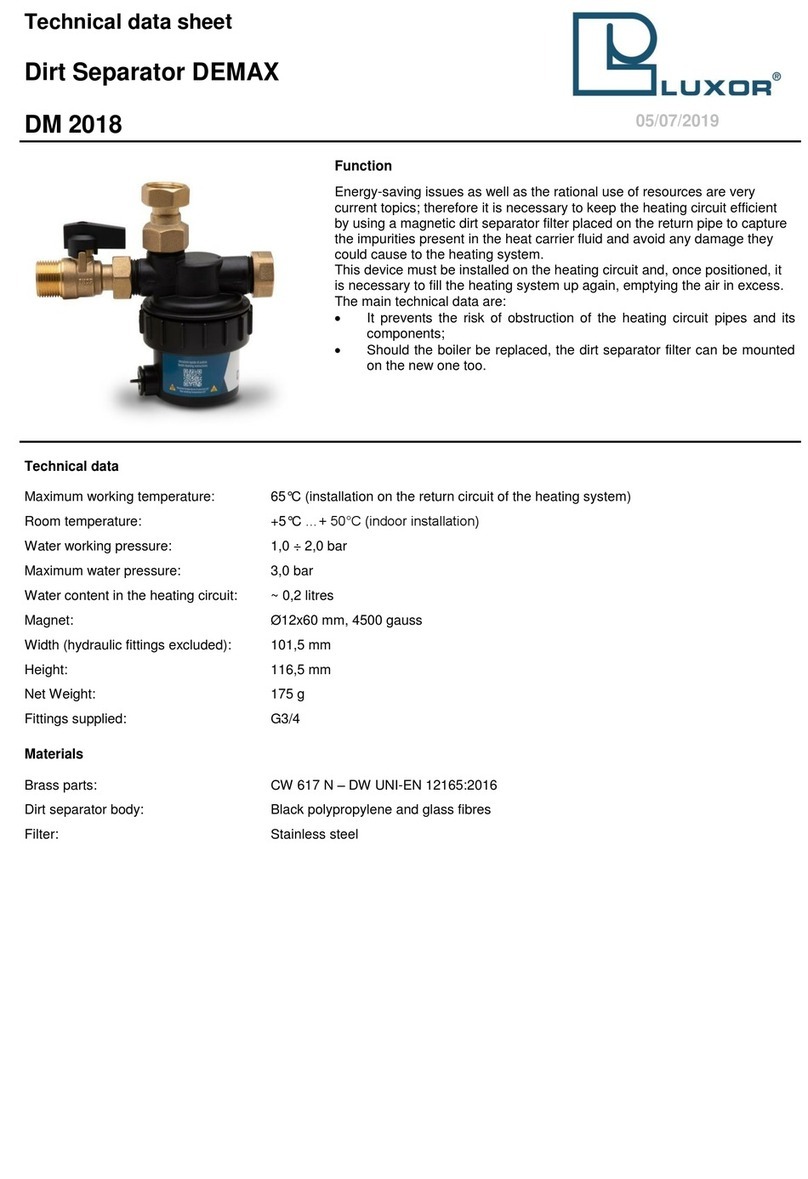
Luxor
Luxor DM 2018 Technical data sheet
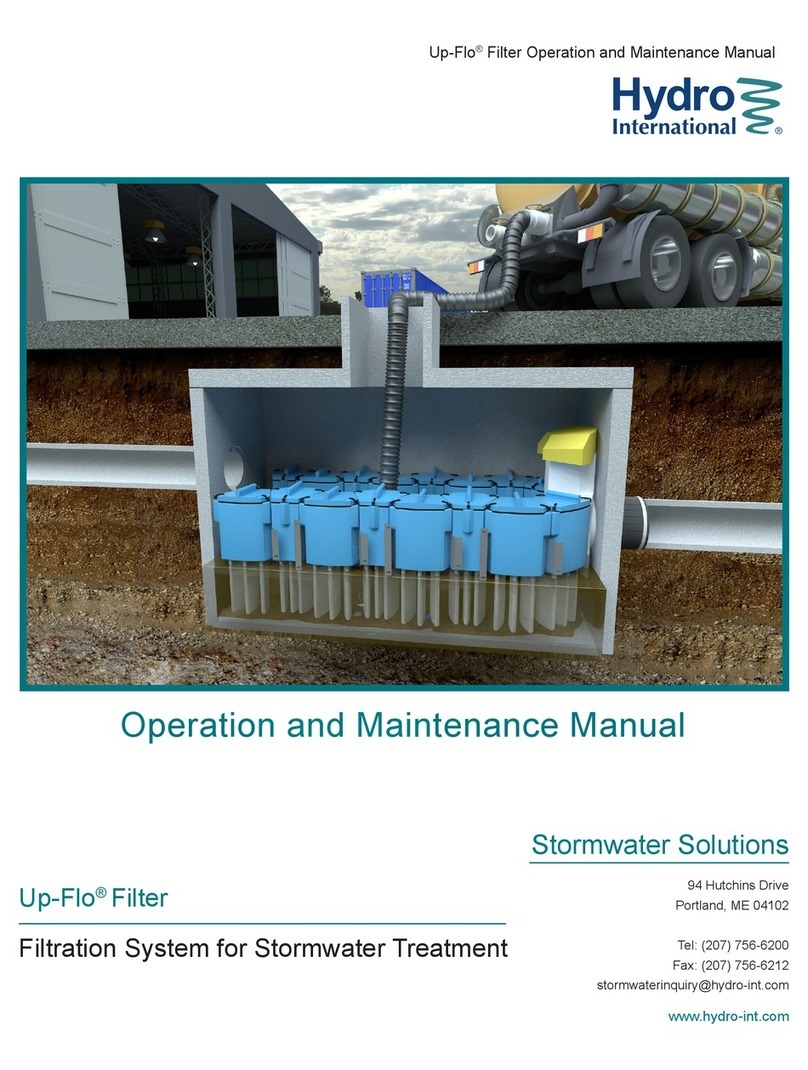
Hydro International
Hydro International Up-Flo Operation and maintenance manual

Pool Technologie
Pool Technologie JUSTSALT UNO user manual
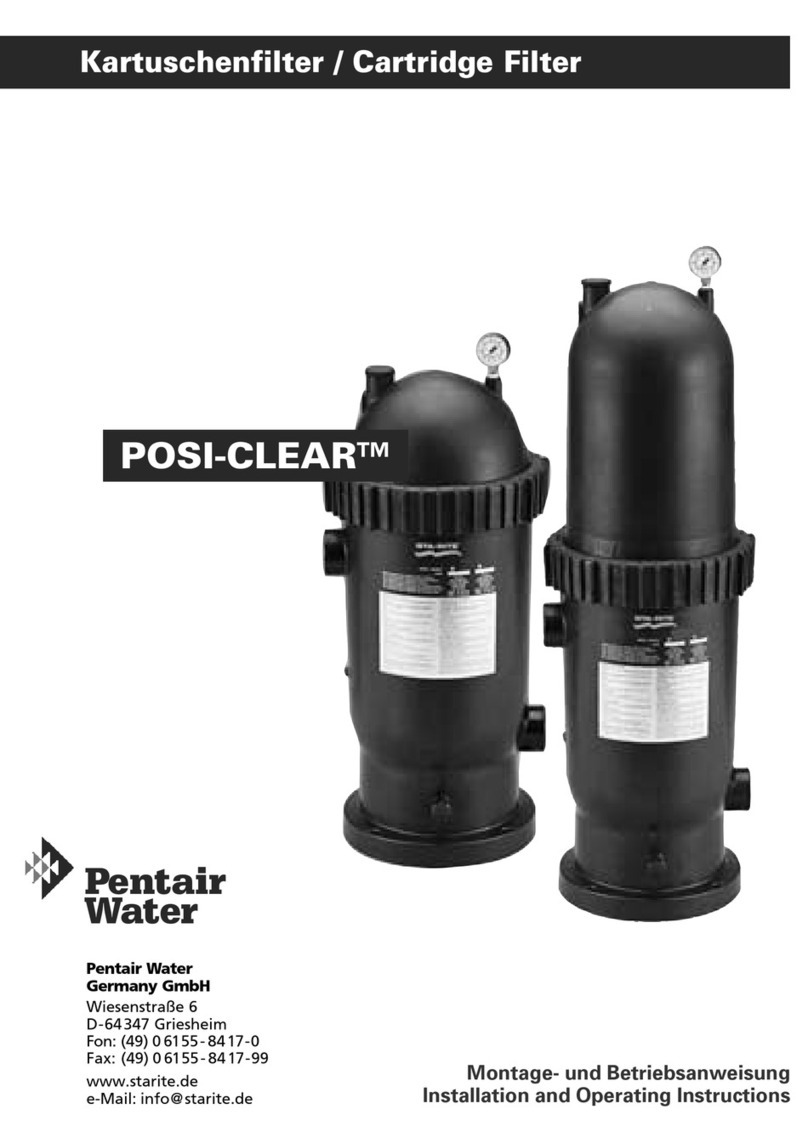
Pentair Pool Products
Pentair Pool Products POSI-CLEAR PXC Series Installation and operating instructions
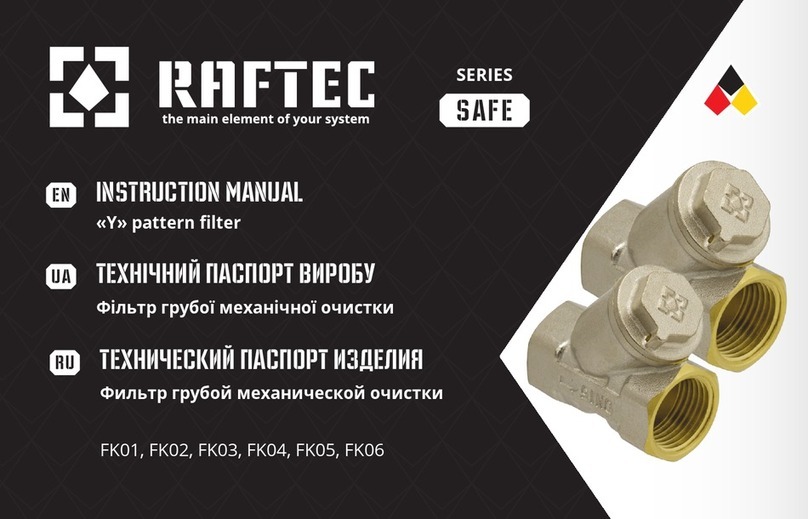
RAFTEC
RAFTEC SAFE Series instruction manual
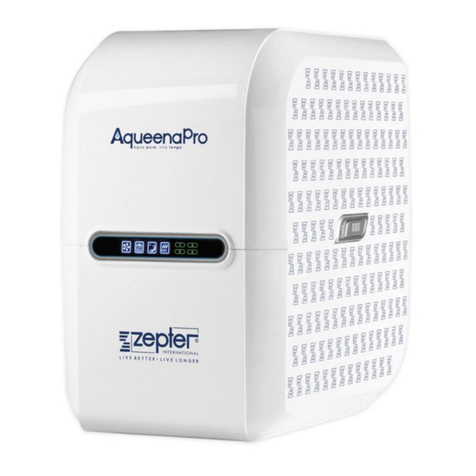
Zepter
Zepter AqueenaPro WT-100 instruction manual

